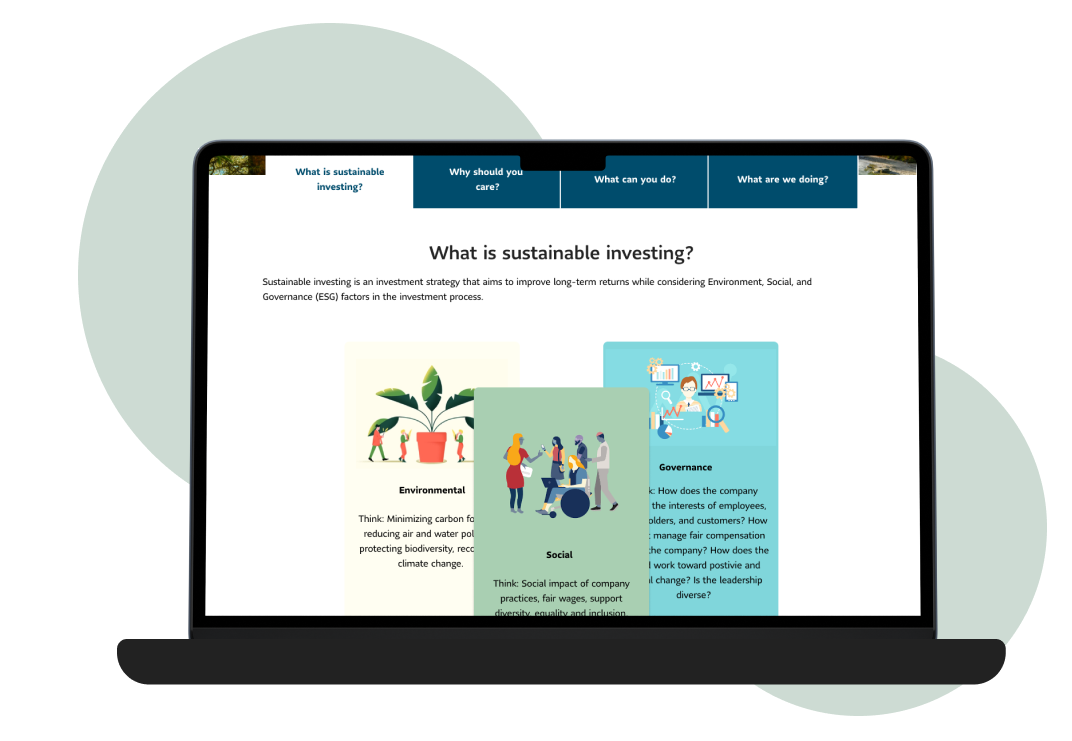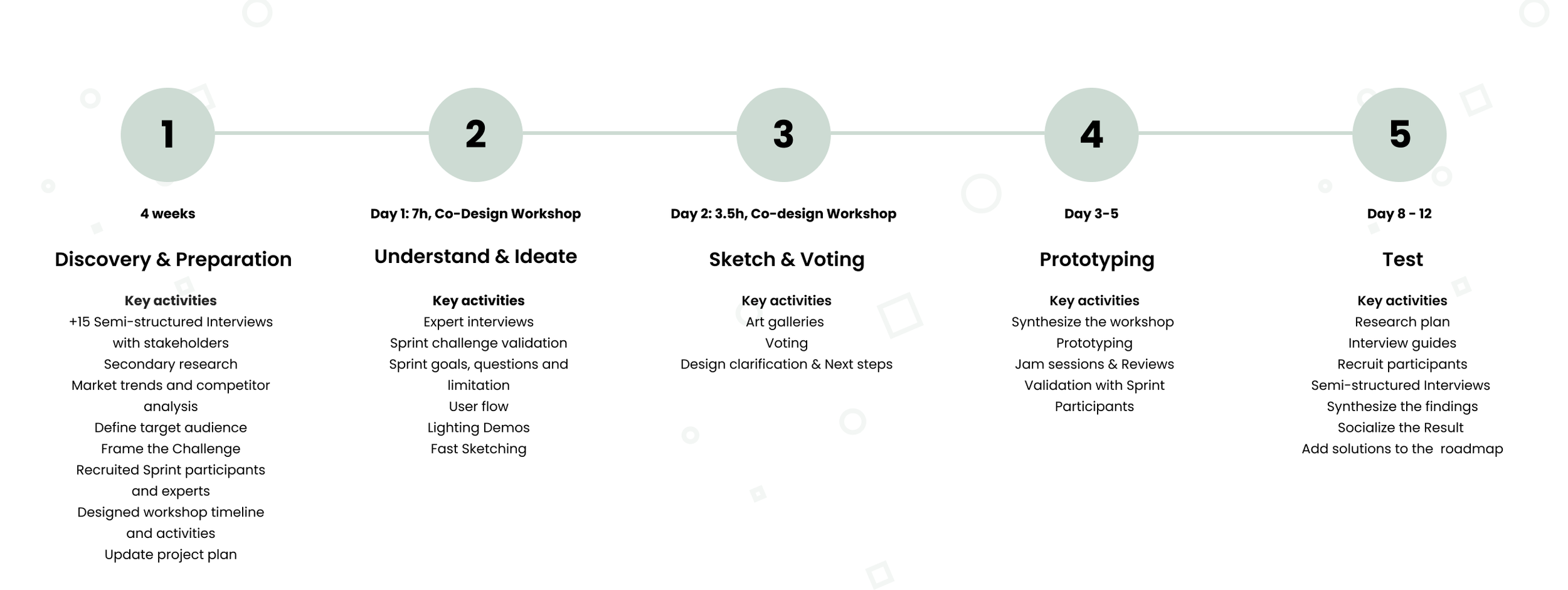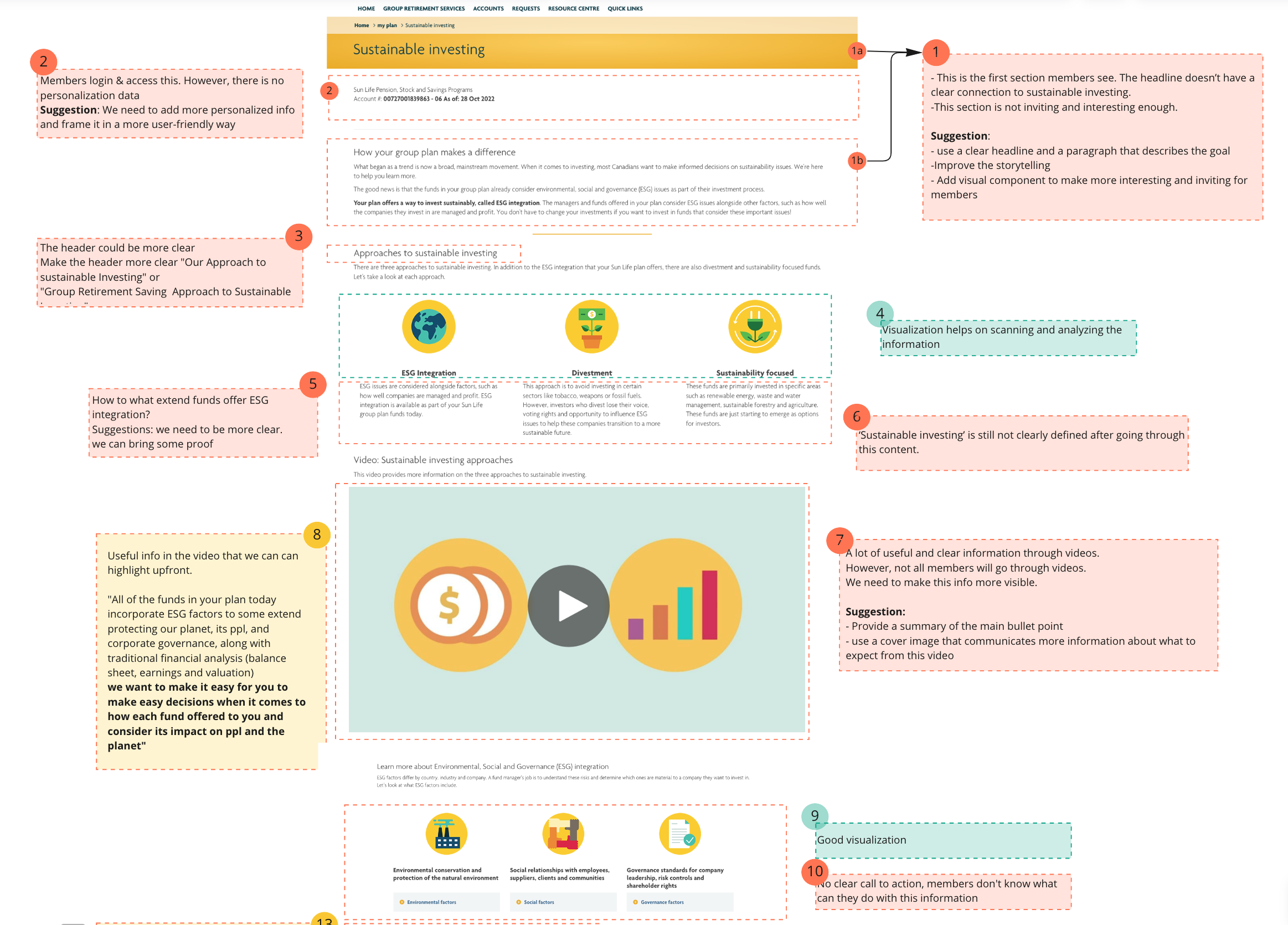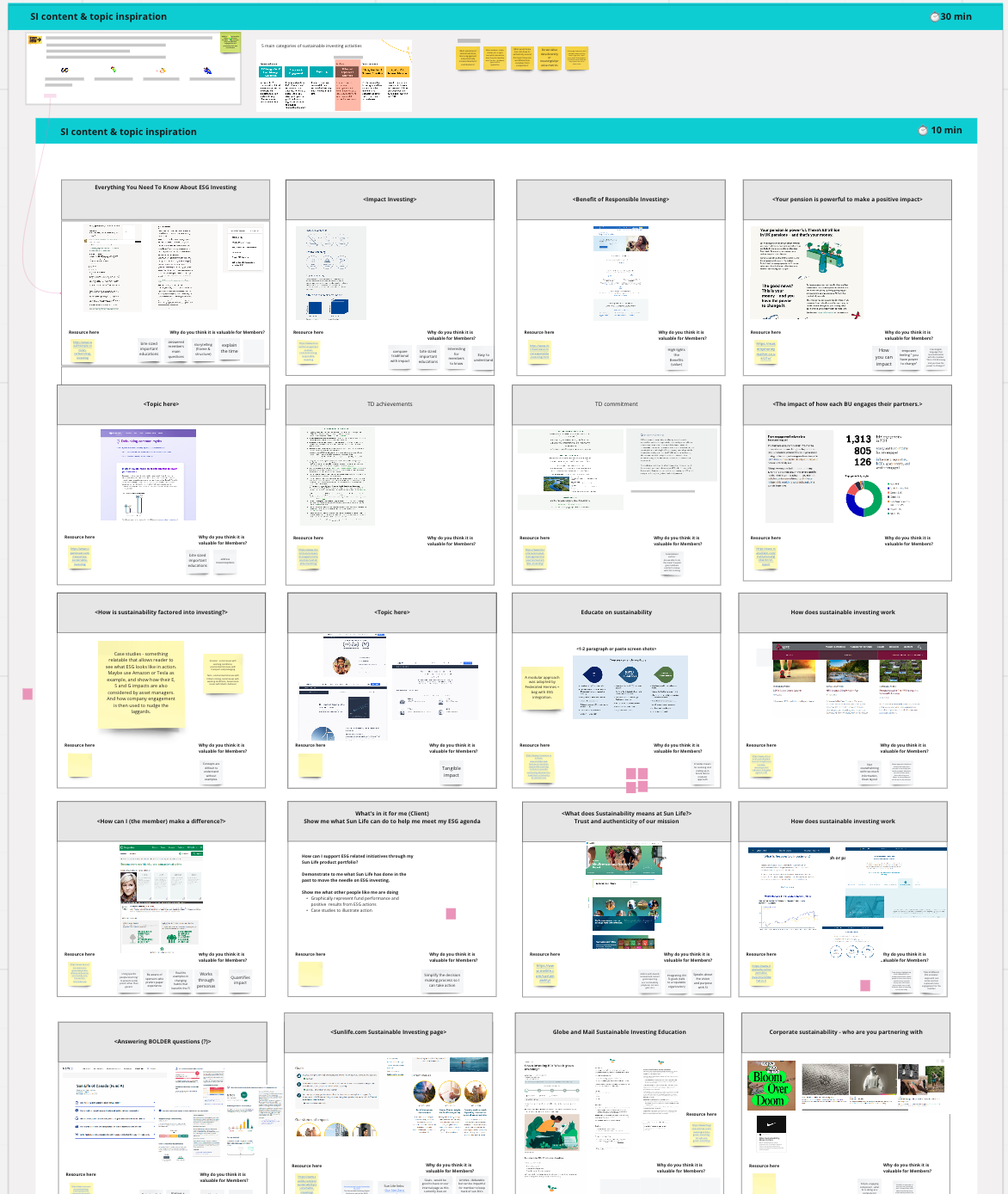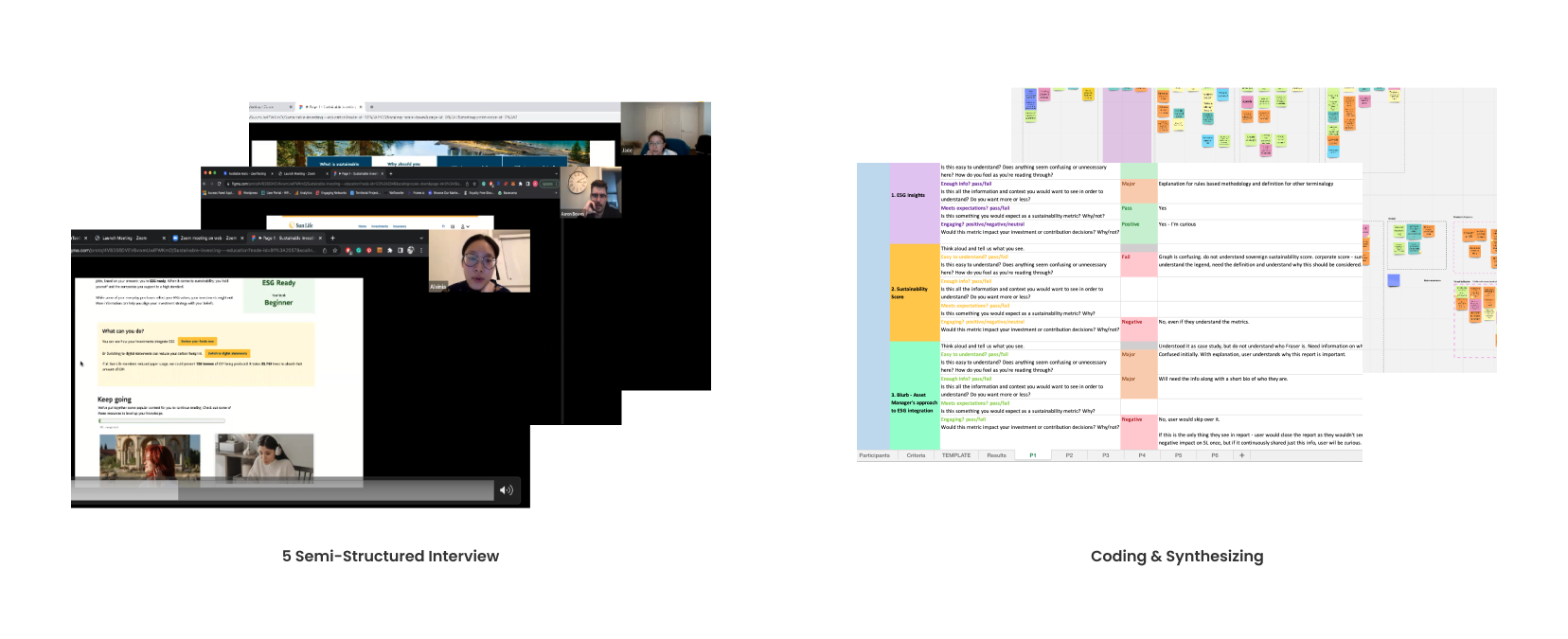Sustainable Investing Concepts: Leveraging GV Design Sprint
Role: Lead Product Designer | Client: Sun Life Financial | Time: August 2022- Feb 2023
Background
How might we Enhance the client experience by effectively integrating sustainable investing and addressing their needs and expectations?
Sustainable investing is the evolution of investing and Sun Life Financial aimed to align Sustainable Investing with client expectations and create a cohesive client experience across all BUs. The key objectives of the project were:
Discover near-term sustainable investing opportunities by understanding client preferences and expectations
Foster collaboration among cross-functional teams and develop a consistent sustainable investing strategy
Assess competitors' strategies and benchmark Sun Life's sustainable investing approach
Create tangible concept prototypes
Test their desirability with real users
Define next steps and an implementation roadmap
Role and Responsibilities
I led the end-to-end project by collaborating with cross-functional teams. My main tasks were:
Led a small team of designers to deliver sustainable investing concepts. Responsible for planning and managing project
Facilitated a series of co-creation workshops with internal stakeholders from different BUs
Created tangible sustainable investing concept prototypes through close collaboration with UX designers
led qualitative research to test the desirability of the concepts with users
Defined an alignment on the next steps and an implementation roadmap
Core Team
Lead Designer (Me)
Senior UX Designer
UX Designer
Director of Sustainability Team
Director of the Group Retirement
Director of Journey Design Team
Empowering Financial Literacy
Help clients with low financial literacy understand the basics and value of sustainable investing
Capture client behaviours towards sustainable investing to provide tailored, self-serve educational content
Key Achievements
Led the project and successfully delivered two concept prototypes for Sustainable Investing
Added short-term solution in their 2023 plans
Customize Design Sprints to fit the problem and the team
Made significant progress in a short period quickly and efficiently by working with cross-functional teams
Assisted BUs make more informed decisions about their products
Enhanced the client experience by delivering new Sustainable Investing concepts into the existing solution
Received recognitions from leadership in various business units
“The well-organized sprint and outstanding results have provided us with an effective and quick solution to improve the sustainability experience”
- Director of SunLife GRS
“Peggy has a vision of how she would like workshops to flow and has very good discipline in driving the workshops against her vision. Her combination of preparedness and facilitation are a great skill set to have, especially in a scenario with multiple stakeholders, and quick turn-around timelines”
-Director of Sun Life Sustainability Team
Methodology and Process
I leveraged Google Venture Design Sprint and crafted each sprint from scratch to tailor to our specific needs.
Discovery & Preparation
Design Sprints are powerful processes, but in order to be successful preparation is critical. Main prep works were:
Arranged meet-ups, daily status calls, and review sessions with the designers to align and establish a good way to work
Semi-structured Interviews with 20+ stakeholders to a better understanding of the situation and define the challenge
Recruited Sprint participants, Experts to share their knowledge and select a decider
Studied market trends and competitors and leveraged previous research
Designed workshop timeline and activities
Framing The Challenge Right
I believe identifying the right problem is key to sprint success. After synthesizing the stakeholder’s interview and secondary research on Sustainable Investing, the target audience, current experience and potential opportunities. I defined the sprint challenge and validated it with the decider.
Clients Challenges
Lack of Knowledge and Guidance: Clients feel uninformed about sustainable investing, how it aligns with their financial goals and lack resources to educate themselves effectively
Limited Awareness and Engagement: Clients do not naturally consider sustainable investing unless prompted
Personalized Education: Financial institutions offer generalized education, there is an opportunity to provide personalized sustainable investment education
Business Challenges
Lack of a clear strategy and direction from leadership regarding sustainable investing
There is a lack of alignment and coordination between different business units in terms of their approach to sustainable investing
Communication and messaging consistency in conveying Sun Life's approach to sustainable investing
Day 1: Monday -Understand & Ideate:
The sprint starts with Expert Interviews (share knowledge). The aim was to understand the current experience, the challenge, the context, the target audience and the principles that matter for educating customers. While experts were sharing knowledge, the participants took notes and asked questions from experts.
Then, we moved forward to review and validate the sprint challenge that was created by me and evolved by deciders based on the primary and secondary research data. After that, the participants create long-term goals, current constraints and sprint questions. There was a group discussion after each activity and the decider choose the final version.
Next activity was lighting demos: we went through 35+ inspiring examples about Sustainable Investing education that I had gathered before the workshop. Then I asked the participants to spend 15 min, share additional inspiring examples. Finally, everyone presented their examples and explained why this solution inspired them By gathering most of the examples prior to the workshop, we saved time and could focus more on group discussions and decision-making.
The Day 1 workshop concluded with the fast sketching activity, where participants spent 1 to 1.5 hours offline sketching potential solutions to the challenge. The goal was to streamline the workshop and reduce Day 2's duration to just 3 hours.
Day 2: Tuesday - Ideate and decide
On Day 2 of the workshop, we began by allowing participants to individually review each concept and vote based on the sprint challenge and goals. Then, each participant explained their ideas in detail, allowing others to ask questions and potentially change their votes. Following that, we have a group discussion and the deciders voted on three concepts. The sprint workshops ended by letting UX team to clarify any uncertainties and concerns about the design.
Prototype
As the Lead Designer, I effectively managed a team of two designers, establishing clear project goals, responsibilities, and timeline for deliverables. Daily check-ins, brainstorming, and review sessions fostered collaboration and problem-solving. I provided guidance, mentoring, and feedback to support the team. The initial version of the prototype was reviewed by decision-makers and sprint participants, their feedback was incorporated to refine the design. The prototype addressed the following key areas based on the findings from workshops:
Help clients with low financial literacy understand the basics and value of sustainable investing and clarify Sun Life's approach to sustainable investing
Capture client behaviours and attitudes towards sustainable investing to provide tailored, self-serve educational content
Test the Desirability
The purpose was to test the desirability of the concept. I conducted semi-structured interviews with 5 users. The main research questions were:
What are the most and least relevant and engaging content
Will sustainable investing education result in more contribution and engagement
What are touch-points to engage Members with SI content
Which sustainable investing approach is the most appealing
What do clients expect to do next
Positive Outcomes
Engagement and Action: The SI education page effectively engages members, raises awareness, builds trust, and guides them to take action on sustainable investing. Most engaging content: approaches, myths about sustainable investing
User Experience: Users find the layout and structure easy to use, engaging, and straightforward, with sticky tab navigation enhancing discoverability.
Visual Content and Interactivity: The interactive elements and visual aspects such as statistics make the page engaging and credible.
Areas for Improvement
Contribution Increase: The findings suggest that users were open to increasing their contributions based on specific elements such as statistics, myths, achievements, goals, and the "Review Funds" action. Adding testimonials and ESG performance statistics within Sun Life or external sources is recommended.
Promoting Awareness: Promoting the SI page through multiple channels and making it visible in the Sun Life portal
Make information clear: Research shows we should explain sustainable investing simply, for beginners, and use real-life examples.
Solution
I successfully led this project and facilitated collaboration among stakeholders from different business units. As a result, we identified 8 short-term solutions, quick to implemented have a moderate impact, 2 long-term solutions, require more effort but with significant potential impact. The business unit sponsor was thrilled with the results and was confident in including the short-term solution in their 2023 plans.
This project made a big impact and went beyond expectations. It was the first time all business units worked together and resulting in tangible sustainable investing concepts. Receiving highly positive feedback from important stakeholders confirms the effectiveness of the design sprint process, highlighting our ability to deliver tangible results, manage stakeholders, human-centric design and drive innovation. As a next step, we worked with project managers and shared the initial designs.
Director of The Journey Design Team expressed her satisfaction with my work: ‘Amazing work planning, putting together and facilitating the second design sprint! You were thoughtful and well prepared and that shows how easily all the activities flowed, the engagement from participants and the stakeholder feedback.’
Takeaways
This design sprint had a slightly different focus compared to a typical Design Sprint, for two main reasons:
Goal: The main objective was to explore the potential business opportunities in sustainable investing.
Stakeholders: We brought together important business units at Sun Life, each with their own expectations. This sometimes led to conflicts among them.
To address these challenges and ensure success, I took three main approaches:
One-on-One Interviews: I conducted interviews with all participants. This helped me understand their perspectives and find common ground to align expectations.
Customized Design Sprint: I tailored the workshop activities to match the project's goal, participants' expectations, and timeline. I focused on two key considerations:
a. Efficiency: I planned productive workshops by carefully timing the activities and avoiding an overloaded schedule.
b. Collaboration: I allocated sufficient time for group discussions. This fostered collaboration and helped resolve conflicts.
Manage Stakeholders: As the main facilitator, my main task was to effectively manage these stakeholders. we implemented three primary engagement levels throughout the project. This provided clarity, structure, and clear expectations for everyone involved. By fostering effective collaboration and ensuring a smooth progression, we aimed to achieve project success.
